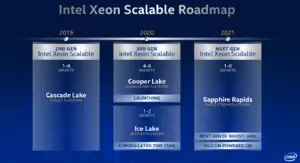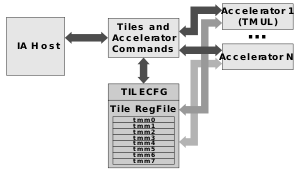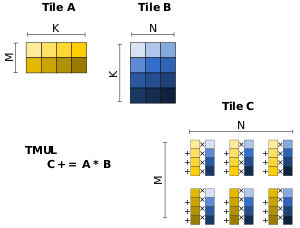(→Microarchitecture support: sapphire supports all three. got confirmation from Intel) |
|||
| (4 intermediate revisions by the same user not shown) | |||
| Line 1: | Line 1: | ||
{{x86 title|Advanced Matrix Extension (AMX)}}{{x86 isa main}} | {{x86 title|Advanced Matrix Extension (AMX)}}{{x86 isa main}} | ||
| − | '''Advanced Matrix Extension''' ('''AMX''') is an [[x86]] extension that introduces | + | '''Advanced Matrix Extension''' ('''AMX''') is an [[x86]] {{x86|extension}} that introduces a matrix register file and new instructions for operating on matrices. |
== Overview == | == Overview == | ||
| − | The Advanced Matrix Extension (AMX) is an [[x86]] extension that introduces a new programming framework for working with matrices. | + | [[File:amx architecture.svg|thumb|right|AMX Architecture]] |
| + | The Advanced Matrix Extension (AMX) is an [[x86]] extension that introduces a new programming framework for working with matrices (rank-2 tensors). The extensions introduce two new components: a 2-dimensional [[register file]] with registers called 'tiles' and a set of [[accelerators]] that are able to operate on those tiles. The tiles represent a sub-array portion from a large 2-dimensional memory image. AMX instructions are synchronous in the [[instruction stream]] with memory load/store operations by tiles being coherent with the host's memory accesses. AMX instructions may be freely interleaved with traditional x86 code and execute in parallel with other extensions (e.g., [[AVX512]]) with special tile loads and stores and accelerator commands being sent over to the accelerator for execution. | ||
=== Palettes === | === Palettes === | ||
| Line 18: | Line 19: | ||
AMX supports a set of accelerators that can operate on tiles. Currently, just one accelerator is defined. | AMX supports a set of accelerators that can operate on tiles. Currently, just one accelerator is defined. | ||
==== Tile matrix multiply unit (TMUL) ==== | ==== Tile matrix multiply unit (TMUL) ==== | ||
| − | The '''Tile Matrix Multiply''' ('''TMUL''') Unit is an accelerator as part of AMX comprising a grid of fused multiply-add units capable of operating on tiles. Its existence is defined by the AMX-INT8 and AMX-BF16 sub-extensions. The TMUL unit comes with a number of parameters supported including the maximum height (<code>tmul_maxk</code>) and maximum SIMD dimension (<code>tmul_maxn</code>). Those parameters are dynamically read by the TMUL unit upon execution. | + | The '''Tile Matrix Multiply''' ('''TMUL''') Unit is an accelerator as part of AMX comprising a grid of fused multiply-add units capable of operating on tiles. Its existence is defined by the ''AMX-INT8'' and ''AMX-BF16'' sub-extensions. The TMUL unit instruction set computes Tile<sub>C</sub>[M][N] += Tile<sub>A</sub>[M][K] * Tile<sub>B</sub>[K][N]. |
| + | |||
| + | The TMUL unit comes with a number of parameters supported including the maximum height (<code>tmul_maxk</code>) and maximum SIMD dimension (<code>tmul_maxn</code>). Those parameters are dynamically read by the TMUL unit upon execution. | ||
== Instructions == | == Instructions == | ||
| + | [[File:amx dot product of tiles.svg|thumb|right|2 x 3 Dot Product]] | ||
AMX introduces 12 new instructions: | AMX introduces 12 new instructions: | ||
| Line 34: | Line 38: | ||
Operation: | Operation: | ||
| − | * <code>TDPBF16PS</code> - | + | * <code>TDPBF16PS</code> - Perform a dot-product of [[BF16]] tiles and accumulate the result. Packed Single Accumulation. |
| − | * <code> | + | * <code>TDPB[XX]D</code> - Perform a dot-product of [[Int8]] tiles and accumulate the result. Dword Accumulation. |
| + | ** Where ''XX'' can be: ''SU'' = Signed/Unsigned, ''US'' = Unsigned/Signed, ''SS'' = Signed/Signed, and ''UU'' = Unsigned/Unsigned pairs. | ||
=== Feature set === | === Feature set === | ||
| Line 42: | Line 47: | ||
{| class="wikitable" | {| class="wikitable" | ||
|- | |- | ||
| − | ! rowspan=" | + | ! rowspan="3" | Instruction !! colspan="3" | Feature Set |
| + | |- | ||
| + | |- | ||
| + | ! Base || colspan="2" | [[#TMUL|TMUL]] | ||
|- | |- | ||
! AMX-TILE !! AMX-INT8 !! AMX-BF16 | ! AMX-TILE !! AMX-INT8 !! AMX-BF16 | ||
| Line 82: | Line 90: | ||
== Microarchitecture support == | == Microarchitecture support == | ||
| + | [[File:intel server roadmap (2020) with amx.png|thumb|right|AMX was first planned for {{intel|Sapphire Rapids|l=arch}}.]] | ||
{| class="wikitable" | {| class="wikitable" | ||
|- | |- | ||
Latest revision as of 21:40, 30 June 2020
Instruction Set Architecture
- Instructions
- Addressing Modes
- Calling Convention
- Microarchitectures
- Model-Specific Register
- CPUID
- Assembly
- Interrupts
- Registers
- Micro-Ops
- Timer
Advanced Matrix Extension (AMX) is an x86 extension that introduces a matrix register file and new instructions for operating on matrices.
Contents
Overview[edit]
The Advanced Matrix Extension (AMX) is an x86 extension that introduces a new programming framework for working with matrices (rank-2 tensors). The extensions introduce two new components: a 2-dimensional register file with registers called 'tiles' and a set of accelerators that are able to operate on those tiles. The tiles represent a sub-array portion from a large 2-dimensional memory image. AMX instructions are synchronous in the instruction stream with memory load/store operations by tiles being coherent with the host's memory accesses. AMX instructions may be freely interleaved with traditional x86 code and execute in parallel with other extensions (e.g., AVX512) with special tile loads and stores and accelerator commands being sent over to the accelerator for execution.
Palettes[edit]
Determining the kind of operations available on specific hardware can be done by enumerating a palette of options.
Currently, 2 palettes exist:
- Palette 0 - initialized state
- Palette 1 - an 8-tile register file with each register being 16 rows x 64-byte (1 KiB) for a total register file of 8 KiB.
A programmer can configure the size of the register file by configuring tiles of smaller dimensions to suit their algorithm. Tiles may be configured in rows and bytes_per_row which are stored as metadata for the accelerator to operate on. Information pertaining to the palette is stored in a tile control register (TILECFG) and is accessible via the palette_table CPUID leaf 1DH. The TILECFG is programmed using the LDTILECFG instruction.
Accelerators[edit]
AMX supports a set of accelerators that can operate on tiles. Currently, just one accelerator is defined.
Tile matrix multiply unit (TMUL)[edit]
The Tile Matrix Multiply (TMUL) Unit is an accelerator as part of AMX comprising a grid of fused multiply-add units capable of operating on tiles. Its existence is defined by the AMX-INT8 and AMX-BF16 sub-extensions. The TMUL unit instruction set computes TileC[M][N] += TileA[M][K] * TileB[K][N].
The TMUL unit comes with a number of parameters supported including the maximum height (tmul_maxk) and maximum SIMD dimension (tmul_maxn). Those parameters are dynamically read by the TMUL unit upon execution.
Instructions[edit]
AMX introduces 12 new instructions:
Configuration:
-
LDTILECFG- Load tile configuration, loads the tile configuration from the 64-byte memory location specified. -
STTILECFG- Store tile configuration, stores the tile configuration in the 64-byte memory location specified.
Data:
-
TILELOADD/TILELOADDT1- Load tile -
TILESTORED- Store tile -
TILERELEASE- Release tile, returns TILECFG and TILEDATA to the INIT state -
TILEZERO- Zero tile, zeroes the destination tile
Operation:
-
TDPBF16PS- Perform a dot-product of BF16 tiles and accumulate the result. Packed Single Accumulation. -
TDPB[XX]D- Perform a dot-product of Int8 tiles and accumulate the result. Dword Accumulation.- Where XX can be: SU = Signed/Unsigned, US = Unsigned/Signed, SS = Signed/Signed, and UU = Unsigned/Unsigned pairs.
Feature set[edit]
Not all hardware implementations support all operations. The AMX extension comprises three sub-extensions: AMX-TILE, AMX-INT8, and AMX-BF16.
| Instruction | Feature Set | ||
|---|---|---|---|
| Base | TMUL | ||
| AMX-TILE | AMX-INT8 | AMX-BF16 | |
LDTILECFG |
✔ | ||
STTILECFG |
✔ | ||
TILELOADDTILELOADDT1 |
✔ | ||
TILESTORED |
✔ | ||
TILERELEASE |
✔ | ||
TILEZERO |
✔ | ||
TDPBSSD
|
✔ | ||
TDPBF16PS |
✔ | ||
Detection[edit]
| CPUID | Instruction Set | |
|---|---|---|
| Input | Output | |
| EAX=07H, ECX=0 | EDX[bit 22] | AMX-BF16 |
| EDX[bit 24] | AMX-TILE | |
| EDX[bit 25] | AMX-INT8 | |
Microarchitecture support[edit]

| Microarchitecture | AMX-TILE | AMX-INT8 | AMX-BF16 |
|---|---|---|---|
| Sapphire Rapids | ✔ | ✔ | ✔ |
Intrinsic functions[edit]
Bibliography[edit]
- Intel Architecture Instruction Set Extensions and Future Features Programming Reference, Revision 40. (Ref #319433-040)

